How to make a birdhouse: from boards and logs for different birds
Attracting birds to the site is both useful and pleasant. It is useful because they destroy insect pests, it is pleasant to listen to their singing and observe the behavior of birds. Therefore, many people come up with an idea - to build a birdhouse with their own hands. People over 40 years old, at the same time, can remember their school years: in labor lessons, boys made houses for birds. But it's not just site owners who make birdhouses. Often, residents of apartment buildings hang them on trees near the house, on balconies and loggias.
The content of the article
What to make
The answer is unequivocal - from wood, moreover from hardwood: conifers are too resinous. The resin can stain the plumage, resulting in death of the bird. You shouldn't use plywood either, Chipboard or OSB... In such nesting boxes, rarely anyone settles: glue and binders scare away birds. For the same reason, we collect and fasten the workpieces only with nails or screws, we do not use glue.
Most often, birdhouses are made from boards. The thickness of the boards is at least 20 mm. This thickness is sufficient to maintain a stable temperature inside, which is important when breeding chicks. Moreover, the boards need non-planed, in any case the inner surface should be rough. The front part under the taphole is also specially scratched: along these notches, chicks and birds rise to the taphole.
So that the boards do not crack when assembling, we pre-drill holes for the screws. The diameter is slightly less than the diameter of the screw.
Birdhouse sizes for different types of birds
To attract different species of birds, the size of the house must be changed. Basically, the proportions of the "body" itself and the entrance area change. The task is to create more familiar nesting conditions for this species.
| Bird species | Bottom dimensions | Birdhouse height | Taphole dimensions | Note |
|---|---|---|---|---|
| Starlings | 10 * 10cm | 30-40 cm | about 5cm | the entrance is preferable to a round shape |
| Titmouse - tits, flycatchers, redstarts, sparrows, passerine owls | 10-12 cm | 25-30 cm | 30-35 mm | round entrance |
| Lesser titmouse or flycatcher (flycatchers, redstarts) | 10 * 8cm | 25-30 cm | 30 mm | |
| Half-duplex | 10 * 8cm | 20 cm | height 33-50 mm across the entire width of the wall | notch - longitudinal slit in the entire width of the front wall |
As you can see from the table, basically only the height changes. The width remains more or less stable. You shouldn't make more birdhouses. They will stimulate the laying of more eggs, and the birds will not be able to fully feed a large number of chicks, as a result the offspring will be weak and, most likely, will die.
If you want to attract wagtails, make a nesting box laid to one side: its height will be 10-12 cm, and its width - 35-40 cm, with the same small entrance located approximately in the middle. Wagtails have weak legs, and they cannot climb the high wall to the tap hole. Therefore, such a choice of nesting sites. in the wagtail, it is also advisable to make a trap about 10 cm wide in front of the entrance - so that they can enter on foot.
The half-duplex requires some explanations. Some birds are used to nesting not in hollows, but in hollows between branches. They rarely settle in a completely closed artificial nesting site. If you want to attract, for example, a gray flycatcher, make a small box for it, in which the entrance runs along the entire width of the front wall.
Just keep in mind that some types of squirrels also like to settle in such houses.
There is one more nesting place that birds often like more - the nesting house. This is a birdhouse, hammered out of a piece of log. Often a dead tree is sawn into blocks of suitable size, turning it into apartments for birds. The height and diameter are selected based on the dimensions that were indicated for a regular birdhouse. The bottom and roof in the nest box are made from a piece of board.
If the entrance is small in the birdhouse, the lid is made removable. This is necessary in order to be able to process the insides from parasites. Sometimes it happens: birds live in a row for several years, and then they stop settling. It's just that parasites have multiplied inside. After removing the lid and throwing out the old nesting place, the birdhouse is scalded with boiling water. This is enough. You can also treat the inside with a weak solution of potassium permanganate (slightly pinkish).
Safety
It is a shame and a pity when birds' nests are ruined. This is mainly done by cats, and even woodpeckers. Therefore, when you make a birdhouse with your own hands, increase the overhang of the roof. In almost all drawings, it is drawn 5 cm long. In order to protect the birdhouse from the cat, it is necessary to make sure that it cannot reach the entrance. To do this, the roof should protrude at least 7 cm, and it is better to add a couple more - for large specimens. This ledge will also protect from slanting rain: the likelihood of chicks getting wet becomes even less.
Another option is to drive nails onto the lid. The cat is unlikely to get hurt, but it will not work out at ease - they will not give nails.
There are several ways to protect chicks from woodpeckers:
- upholster the entrance with tin:
- drive a few nails around the taphole;
- nail a piece of wood onto the taphole area, the fibers of which run horizontally.
All this will prevent the woodpecker from expanding the entrance and getting to the eggs or chicks. The last trick - an overlay - will also complicate the cat's task: it is more difficult to reach the chick through a long entrance.
They still save themselves from cats and possible invaders with the help of protective belts. They are made either from tin strips or from "brooms". You will understand everything by looking at the picture. Please note that the distances must be kept within 3-4 cm. Then the animals will not be able to jump over the protective belts. There should not be knots, feeders and other possible supports between them and the birdhouse.
Where to hang
Where to hang a birdhouse is also a science. If they are assembled on a tree, then at a height of at least 2.5-3 meters. There should not be paths or lively meta near the selected tree - a well, a bench, etc.
When choosing a place on the tree, keep in mind that there should be no large branches in front of the entrance: the approach should be free. In this case, you need to deploy it so that the "window" looks to the south. All this increases the chances that tenants will settle in your birdhouse.
Another point: you need to tie or nail so that the "house" is tilted slightly forward. So it will be easier for the chicks to get out, and less rain will clog.
How to make a birdhouse with your own hands: photo report
We will make the easiest option - with a flat roof. As already mentioned, we take non-planed hardwood boards with a thickness of 20 mm or more. Wear gloves to avoid splinters. We cut the blanks according to the drawing. Try to keep the cuts even and at right angles: there should be no gaps. Immediately after hatching, chicks are without feathers, and the slightest draft can destroy them. Therefore, all the edges must be even.
We take long thin nails - diameter 1.5-2 mm, length 4-5 cm and a hammer. We start assembling. We nail the sidewalls to the front part at a right angle. For each - three or four nails.
Turning the workpiece upside down, take the bottom, insert it, align it. We nail to the sidewalls. We cover the top with the back wall, we also nail it.Do not forget about connecting the back wall to the sidewalls.
Turning the taphole upwards, we nail the bottom from this side as well. It remains to assemble the roof. We take the remaining square - a double of the bottom, nail it so that the visor sticking out in front is at least 5 cm (preferably 7-10 cm, as they said before). If the nails are sticking out, bend them.
The roof just has to fit snugly. If something gets in the way, we earn money with a chisel. That's all, the birdhouse is ready with your own hands.
Often a perch is installed under the taphole. Do you need it or not? If there are enough branches around, it is better not to do it. If there are no branches, you either need to make a perch or a small shelf, although you can do without them. Why? Because cats also lean on them and it is easier for them to reach the chicks with support.
How to make a titmouse, see the video
We make a nesting house - a birdhouse from a log
If the feathered people have a choice - to settle in a nest box or a birdhouse made of boards - they will choose a nest box. It looks more like the usual "dwelling" - a hollow, there are no cracks in it from the sides and, therefore, it is warmer. They are less visible on the tree, which means more chances to grow offspring. These are pluses from the point of view of birds. Now about the pluses from the point of view of "producers": a fallen tree is used for work, and it is free. If you find a suitable one, it will be enough for a large number of birdhouses. On the downside - making the nest boxes longer and more difficult: you have to manually pick out the core, leaving the walls intact.
Now how to find a suitable tree. Aspen is best suited: it usually rots from the inside, and remains solid along the outer edge. Therefore, we go in search of an aspen forest, and there, among the fallen trees, we are looking for a suitable one: we cut several trunks. It is important to find with a whole edge and a rotten middle - the work will go faster.
Often such trees have rotten bark, which makes them look unsightly. We clean off the bark, pull the log to the dacha or to the house. There we cut into blocks of suitable size. Dimensions are determined by diameter. For a birdhouse, the inner diameter of the nest box should be 22-30 cm, respectively, the outer diameter is 27-36 cm.For the titmouse, the segments closer to the top are suitable - the inner diameter is 15-22 cm, the outer diameter is 19-26 cm.
The height of the block also depends on the type of house - a titmouse with a height of 20-40 cm (but they are more willing to settle in low ones), a birdhouse - from 30 to 45 cm.When sawing, try to make the bevel that turns out to be even below, and at the top - at a slight slope - so that rainfall flowed from the roof. For the manufacture of roofs and bottoms, you will need trimming boards, you can use unedged and slab.
We take the cut block and begin to pick the core with a chisel. The task is to dig a through hole. After that, even tough wood is easier to chip off. To make the process go faster, you can drill holes with a drill, then break off the jumpers with a chisel.
As a rule, the rotten core ends quickly, then you have to chop off pieces of wood with a chisel and a hammer or mallet. But with a hole in the center it is much easier - longitudinal pieces are chipped off, the work proceeds at normal speed.
The walls should remain about 1.5-3 cm. We try to earn some money in the middle more or less smoothly, without large chips. When the walls are selected, we make a tap hole. If there are bitches, you can hollow it out. Or take a crust and a drill, drill in a suitable place. If there is no crown, take a regular drill, drill holes in a circle, then, using the same chisel, cut through the remaining jumpers.
A piece of board 2-2.5 cm thick goes to the bottom. It is nailed or screwed onto screws. The protruding parts are cut as close to the walls as possible.
It remains to nail the roof. The same board or croaker will do.Drill the holes before screwing in the self-tapping screw, otherwise the board may split.
Actually, you have already made a birdhouse with your own hands, it remains to protect it from attempts by woodpeckers. If there are knots on the walls, it is advisable to smear them with plasticine (ordinary, children's). They can also fill up the gaps that remain between the bottom and the roof and walls: it is rarely possible to fit everything clearly. If you do not want to cover with plasticine, you can bury it with hemp rope. It is applied to the gap, and pushed into it, with a flat screwdriver (in general, there are special blades for caulking, but they are large - this time, and for "one-time use" to buy them ...). If "goes" badly, you can knock on the handle with a hammer.
How to decorate a birdhouse
While the birdhouse is new, it looks relatively good, but after a couple of months it will darken. This is good for birds - it will become less noticeable and they will only benefit from this. But not all homeowners like to look at such an unsightly "decoration". To improve the appearance, the birdhouse can be painted, but the colors must be chosen "natural" - brown, gray, shades of green. Do you want your birds to survive? This means that their nest must be masked, and not painted in all colors of the rainbow, attracting all possible predators.
We hope that now you can not only make a birdhouse with your own hands, but also decorate it competently (from the point of view of birds).
Dimensional Drawings
Some drawings of birdhouses are in the text, we post a few more in this section. Adjusting the size for the planned "tenants" is probably not a problem. Also note that the layout is for a 2 cm thick board. If the thickness is increased or decreased, adjustments are necessary.

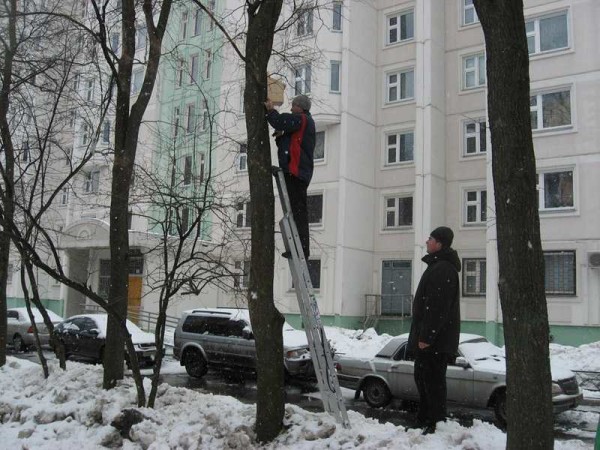
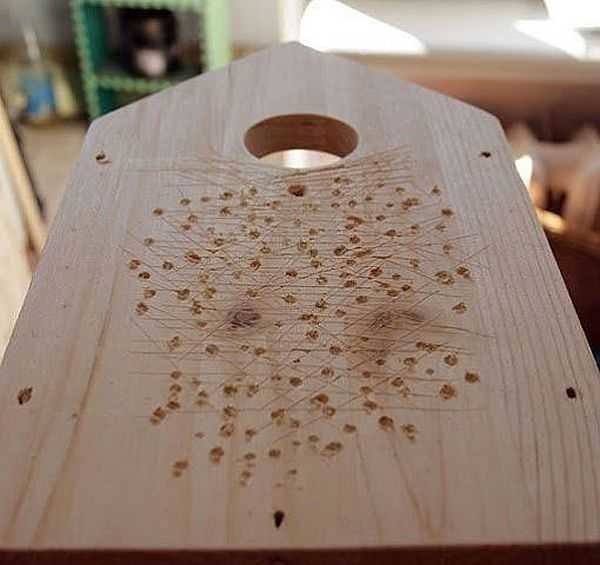
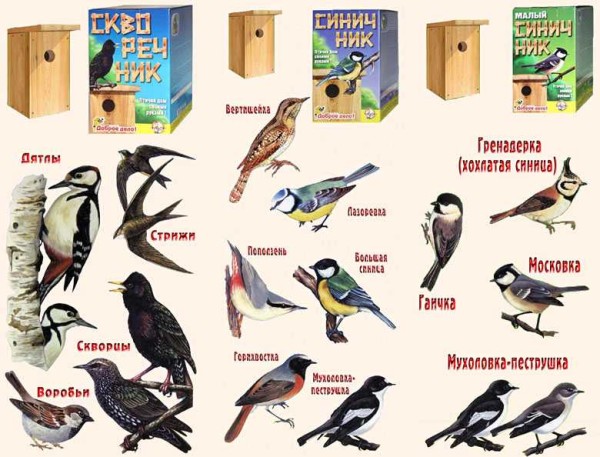

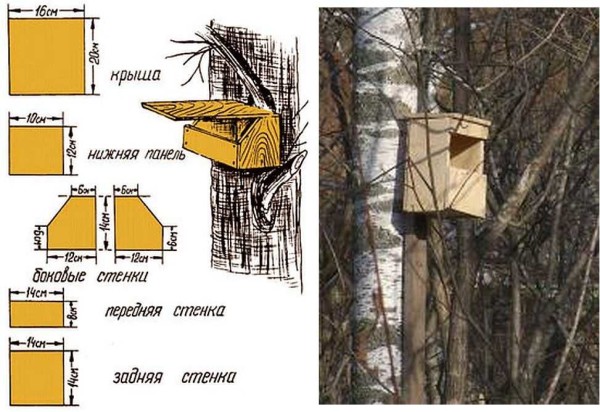
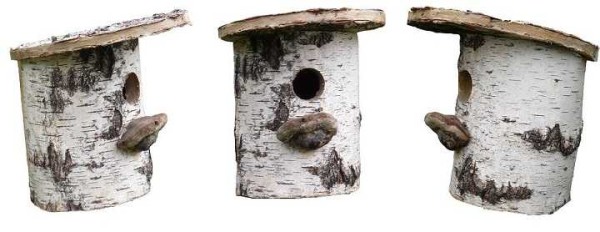
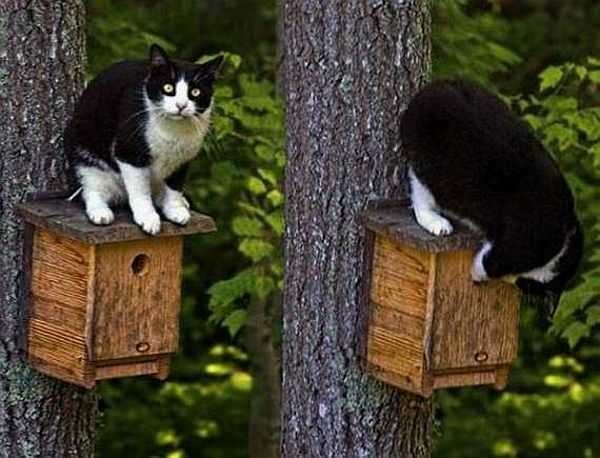
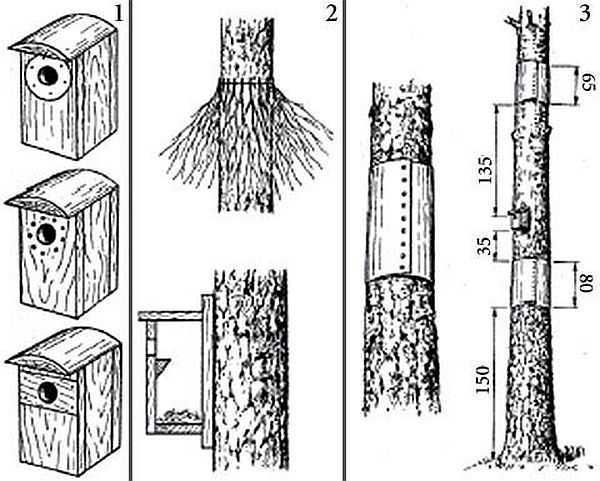
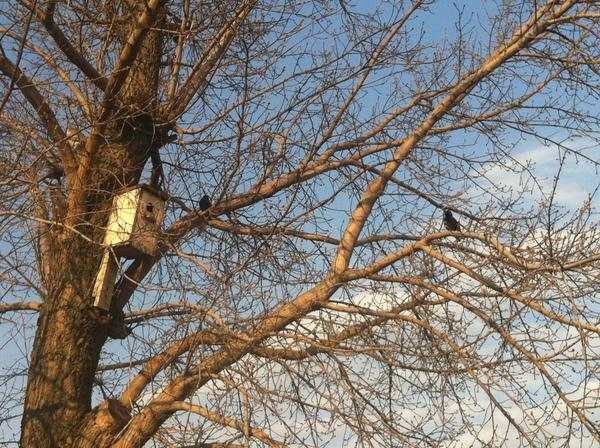
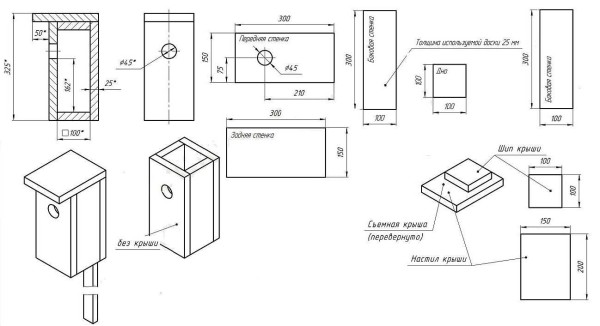
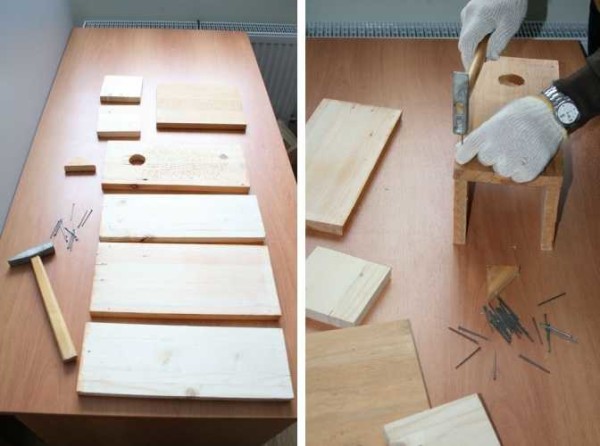
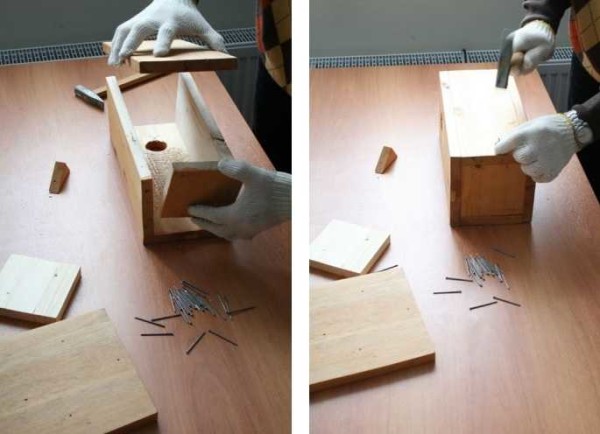
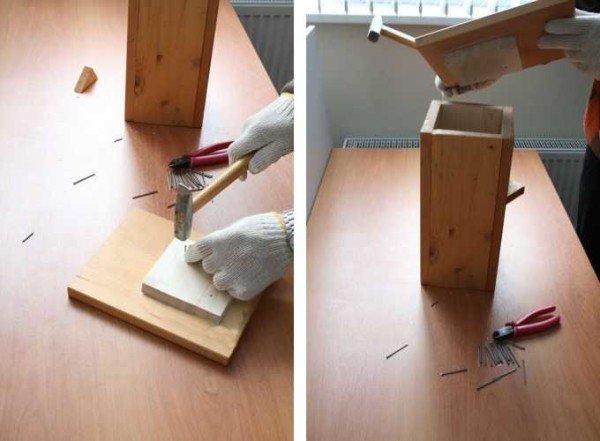
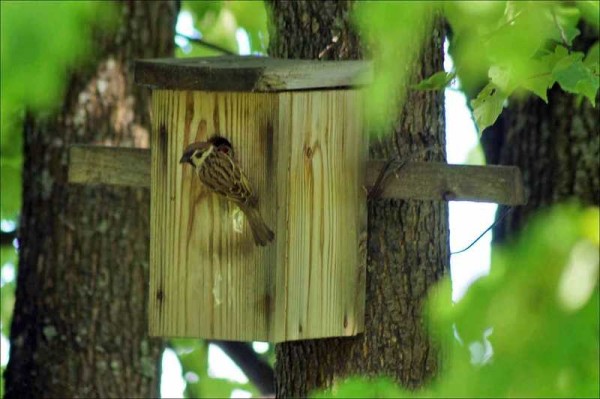
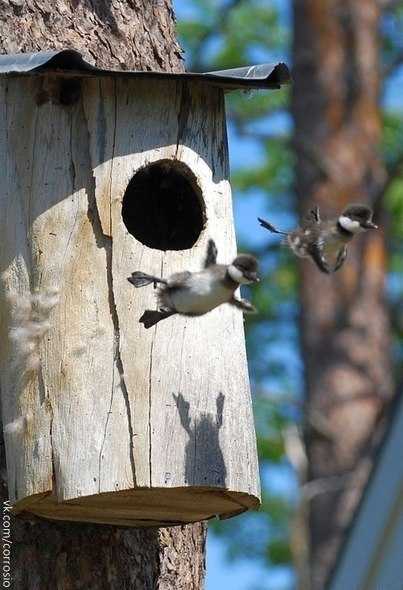
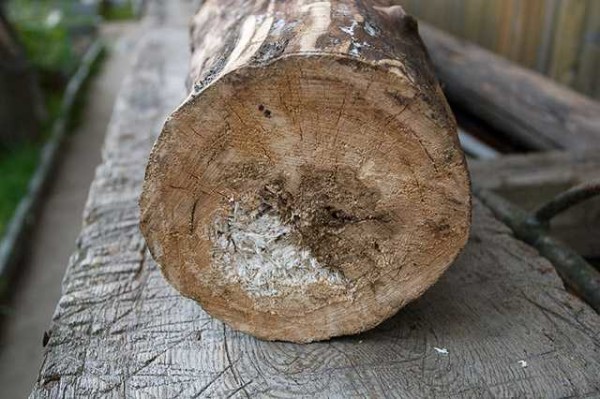
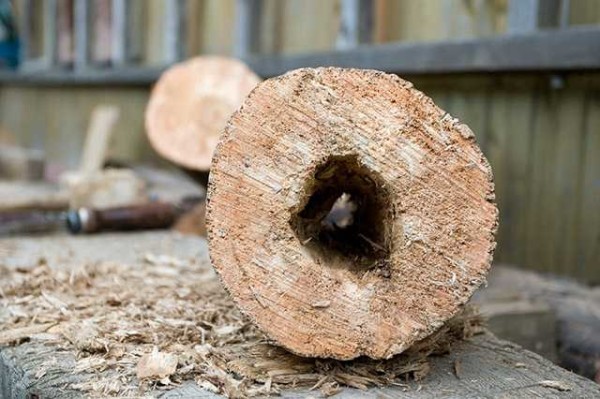
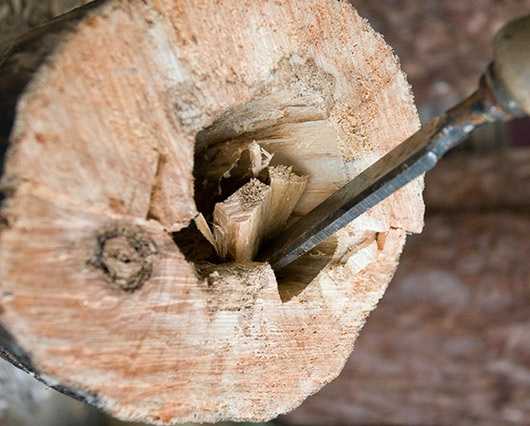
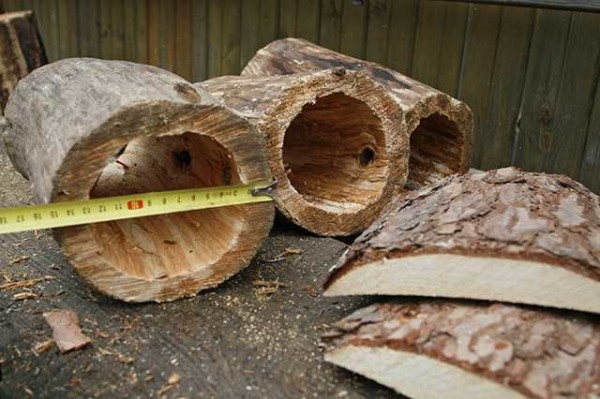
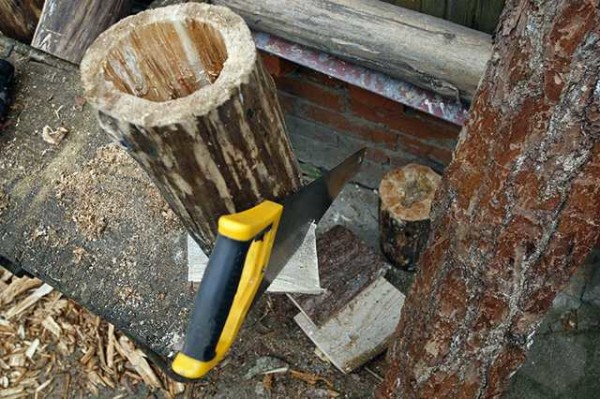
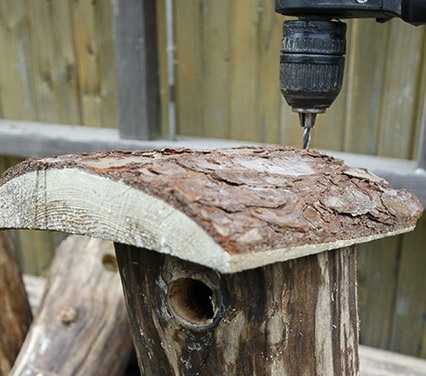
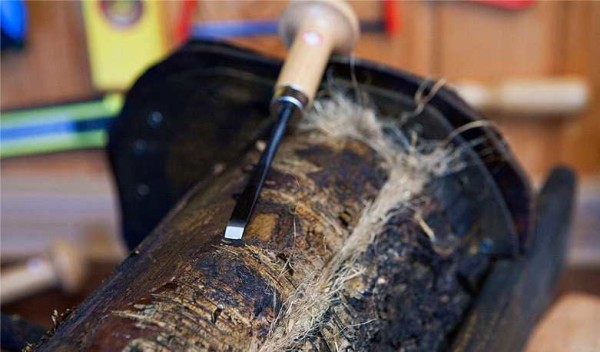
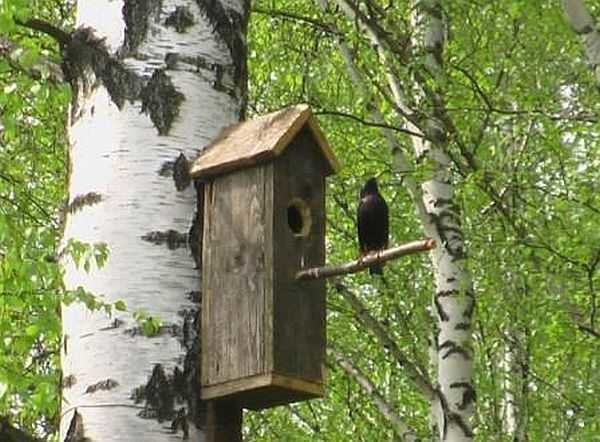
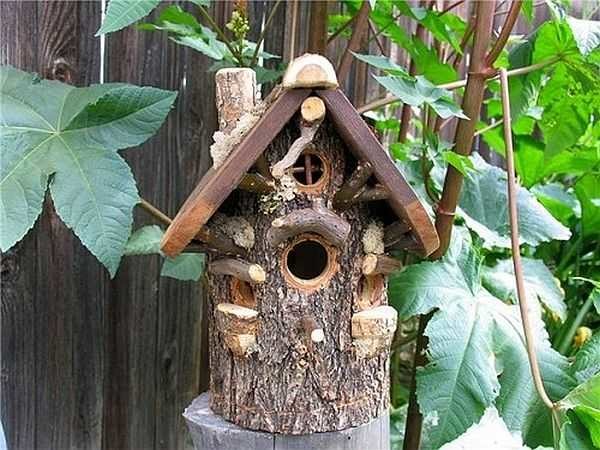
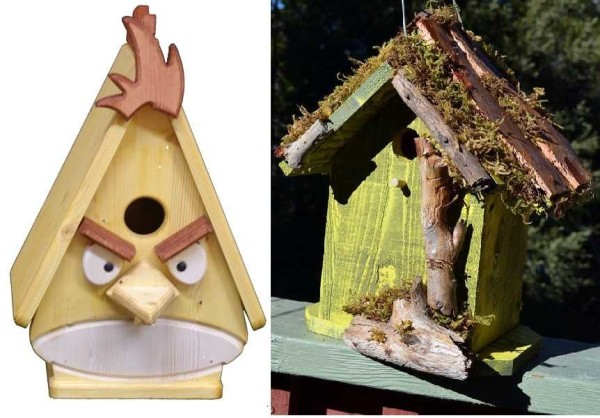
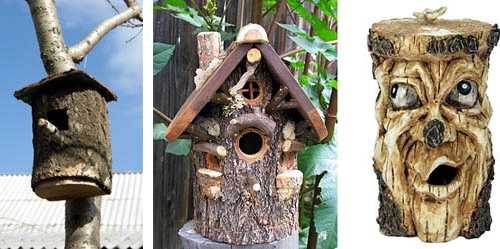
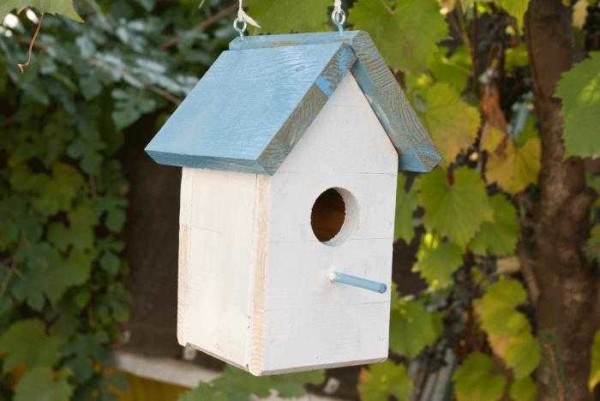
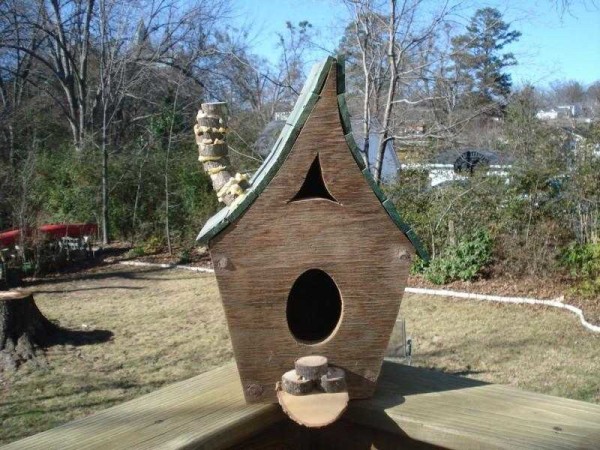
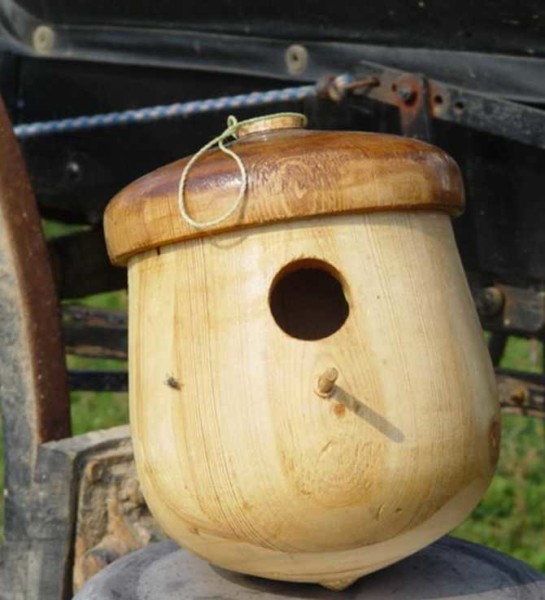
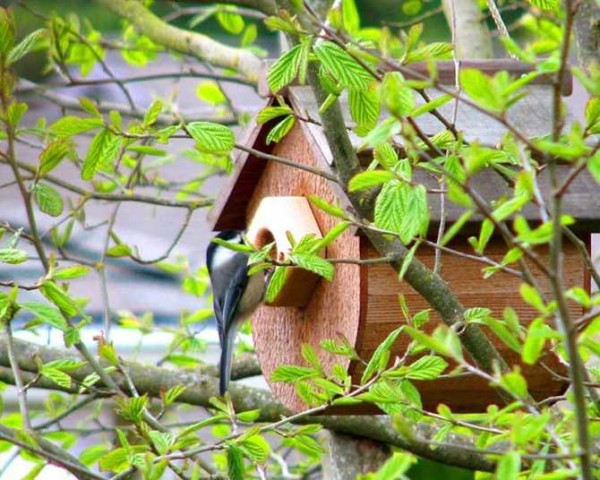
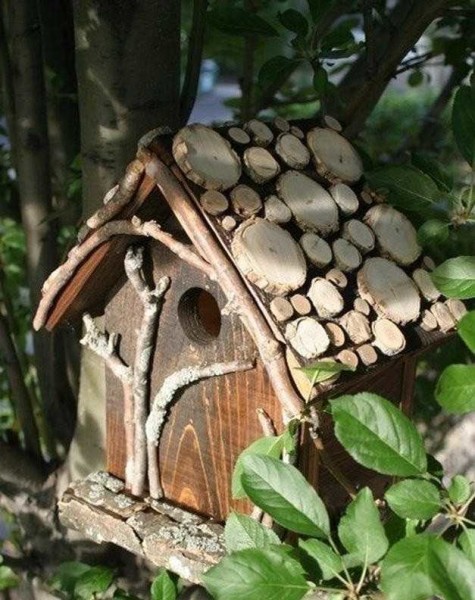
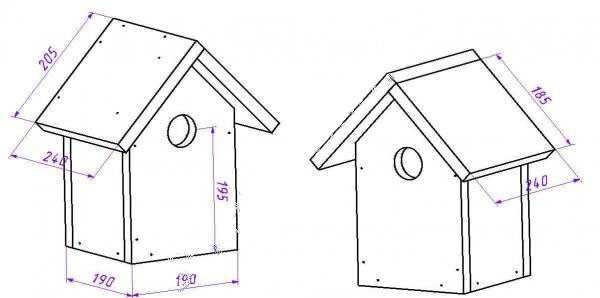
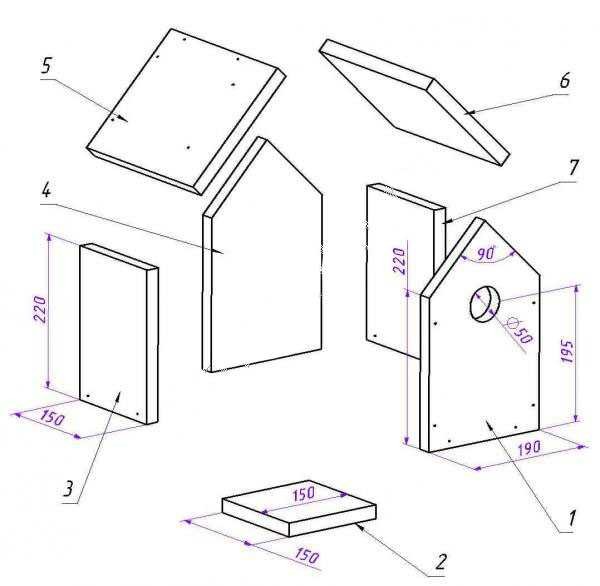
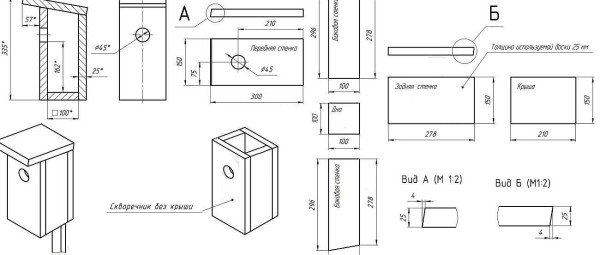


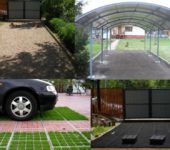
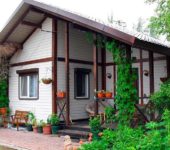
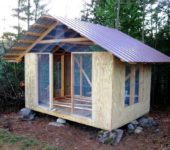





Thank you, it's time to make bird houses for spring.
Is it not so easy to find a 190mm wide board, or can you make it out of a furniture board like in one of your photos?
It is possible from a shield, it is possible from several boards, just fit them tightly. You can use a tongue and groove board (with tongue and groove).
Do I need to do another perch inside the birdhouse so that the chicks get out, if deep
They will not come out on the perch. And the letok is made high so that they get there when they are already a little older and stronger.
Tell me, pliz, how crazy is the idea of making a birdhouse for 2-4 families on the balcony (9th floor), in the form of a box with 2-4 holes, but divided into sections inside? Or do the birds not live nearby?
Only a few birds can live together. Those that nest in a heap in nature. If you have such in the region, maybe you will have a bird dorm))
In the layouts of Birdhouses (for starlings) - the bottom is both 100X100 and 150X150.The distance to the taphole from the base is also somehow not specifically written. In different versions - different…. What to give preference to?
Apparently, there is no specifics for the reason that it is impossible to ask the starlings about everything 🙂 As for the bottom, I personally would prefer the size 150 * 150, since the starlings are still not the smallest birds. The distance from the tap hole to the bottom is about 20 cm.
Tell me, pzhlsta, how can you paint a birdhouse? Stain? Acrylic paints? Impregnation? What varnish to cover? Thank you!
It is better not to paint the birdhouse - soon it will “peel off” anyway and look unsightly, but you will obviously not repaint it. Both paint and varnish close the pores through which the humidity is regulated "in the room." But if you really want to paint, then only on the outside and, preferably, in neutral colors - green, brown. The best paint is acrylic. If you want to preserve the color of the wood - then cover the outside with a protective oil for wood (most often used for baths or for treating wooden floors). It will not close the pores and will tint. But these oils are not cheap ...
They are painted with a strong solution of potassium permanganate.
If there is something to sit on in front of the entrance, the magpies will carry off all the chicks.
Duck, after all, you can make a smaller (45 mm) hole diameter in the birdhouse? Then the magpies will not be able to climb.
At one time, forty got into the habit of stealing chicks from a birdhouse every year. We made a pipe from a can of stewed meat to a tap hole (one bottom is completely cut out, and on the second, the segments are bent outward and nailed to the birdhouse), the magpie stopped ruining the birdhouse.
Good